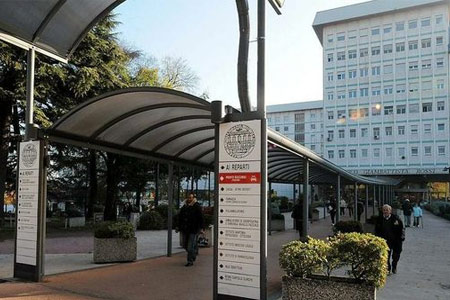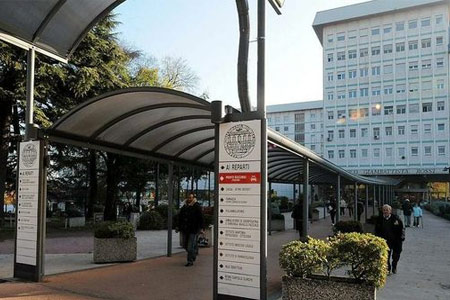- Authors:
-
Vimercati, Alessandro; Tannorella, Pierpaola; Guzzetti, Sara; Calzari, Luciano; Gentilini, Davide; Manfredini, Emanuela; Gori, Giulia; Gaudino, Rossella; Antona, Vincenzo; Piccione, Maria; Daolio, Cecilia; Auricchio, Renata; Sirchia, Fabio; Minelli, Antonella; Rossi, Elena; Bellini, Melissa; Biasucci, Giacomo; Raucci, Annalisa Russo; Pozzobon, Gabriella; Patti, Giuseppa; Napoli, Flavia; Larizza, Lidia; Maghnie, Mohamad; Russo, Silvia
- Title:
-
Distinguishing genetic alterations versus (epi)mutations in Silver-Russell syndrome and focus on the IGF1R gene
- Year:
-
2024
- Type of item:
-
Articolo in Rivista
- Tipologia ANVUR:
- Articolo su rivista
- Language:
-
Inglese
- Referee:
-
No
- Name of journal:
- The Journal of Clinical Endocrinology and Metabolism
- ISSN of journal:
- 0021-972X
- Page numbers:
-
1-32
- Keyword:
-
IGF1R; IGF2-PLAG1-HMGA2 axis; (epi)genetic phenotype; Silver-Russell syndrome; body asymmetry; familial cases
- Short description of contents:
- Context: Silver-Russell Syndrome (SRS) is a growth retardation disorder characterized by pre- and post-natal growth failure, relative macrocephaly at birth, prominent forehead, body asymmetry, and feeding difficulties. The main molecular mechanisms are imprinting alterations at multiple loci, though a small number of pathogenic variants have been reported in the SRS genes IGF2-PLAG1-HMGA2 and CDKN1C. However, around 40% of clinically suspected SRS cases do not achieve a molecular diagnosis, highlighting the necessity to uncover the underlying mechanism in unsolved cases. Objective: evaluate the frequency of genetic variants in undiagnosed SRS patients (NH-CSS≥4), and investigate whether (epi)genetic patients may be distinguished from genetic patients. Methods: 132 clinically SRS patients without (epi)genetic deregulations were investigated by Whole Exome (n=15) and Targeted (n=117) Sequencing. Clinical data from our cohort and from an extensive revision of literature were compared. Results: pathogenic variants were identified in 9.1% of this cohort: 3% in IGF2, PLAG1, and HMGA2 genes, while 3% in the IGF1R gene, associated with IGF-1 resistance (IGF1RES), an SRS differential diagnosis. Overall, IGF2-PLAG1-HMGA2 and IGF1R account for 3.6% of SRS with NH-CSS score ≥ 4. A clinical cross-comparison of (epi)genetic versus genetic SRS underlined (epi)genotype-phenotype correlation, highlighted the prevalence of body asymmetry and relative macrocephaly in mosaic (epi)genetic SRS and recurrence of genetic familial cases. Furthermore, overlapping features were evidenced in (epi)genetic SRS and IGF1RES patients. Conclusion: Our study explores the frequency of genetic SRS, underscores body asymmetry as distinctive phenotype in (epi)genetic SRS and suggests IGF1R sequencing in SRS diagnostic flow-chart.
- Product ID:
-
142456
- Handle IRIS:
-
11562/1144772
- Last Modified:
-
January 31, 2025
- Bibliographic citation:
-
Vimercati, Alessandro; Tannorella, Pierpaola; Guzzetti, Sara; Calzari, Luciano; Gentilini, Davide; Manfredini, Emanuela; Gori, Giulia; Gaudino, Rossella; Antona, Vincenzo; Piccione, Maria; Daolio, Cecilia; Auricchio, Renata; Sirchia, Fabio; Minelli, Antonella; Rossi, Elena; Bellini, Melissa; Biasucci, Giacomo; Raucci, Annalisa Russo; Pozzobon, Gabriella; Patti, Giuseppa; Napoli, Flavia; Larizza, Lidia; Maghnie, Mohamad; Russo, Silvia,
Distinguishing genetic alterations versus (epi)mutations in Silver-Russell syndrome and focus on the IGF1R gene
«The Journal of Clinical Endocrinology and Metabolism»
,
2024
,
pp. 1-32
Consulta la scheda completa presente nel
repository istituzionale della Ricerca di Ateneo 








